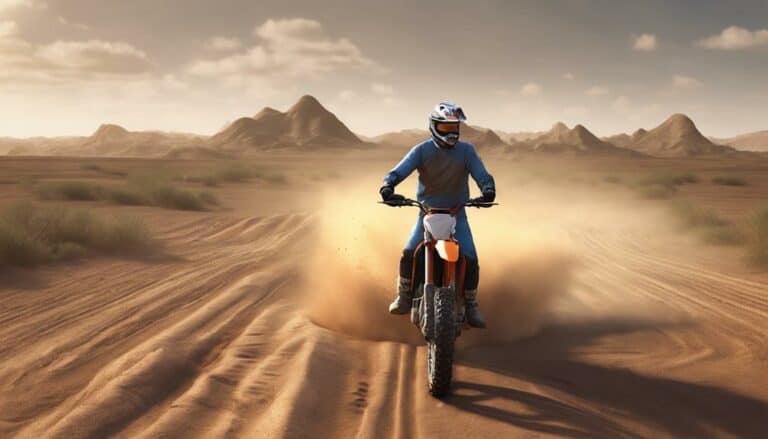You might think off-road riding drills need to be extreme to be effective, but sometimes it's the seemingly simple ones that make the biggest difference.
Have you ever tried a drill that challenges your balance and control in a way you never expected?
Imagine the thrill of mastering a corner or obstacle thanks to a practice that seemed too basic at first.
Stay tuned to uncover some unexpected gems in the world of off-road riding drills that could transform your skills faster than you think.
Key Takeaways
- Practice body positioning drills to enhance control and stability.
- Master braking techniques for quick stops and better control.
- Develop turning skills by leaning the bike and looking ahead.
- Improve obstacle handling through weight shifting and throttle control.
Body Positioning Drill
Enhance your off-road riding skills with the Body Positioning Drill, a fundamental practice that focuses on improving your cornering technique and overall control on challenging terrains. By mastering drills like 'Head Forward Leg High,' you can refine your cornering abilities by shifting your weight effectively through bringing your head forward and raising your leg high. These movements not only enhance your agility but also strengthen your core and leg muscles, essential for maintaining stability and control in rugged off-road conditions.
Moreover, the 'Head Low Standing' drill underscores the significance of maintaining a low head position and hips back stance to optimize throttle and brake control. Correct body positioning is key to distributing weight efficiently, which in turn improves traction and stability while tackling obstacles on the trail. By dedicating time to practice these drills, you'll notice a significant enhancement in your off-road riding skills, becoming more confident and adept at handling various terrains with ease.
Braking Control Exercise
To improve your off-road riding skills further, let's now focus on mastering the Braking Control Exercise, an essential practice that hones your ability to modulate front and rear brakes independently for the best speed and traction management.
- Feel the Brake Lever: Get comfortable with the feel of the brake lever under your fingers to understand its sensitivity.
- Practice Threshold Braking: Learn to apply maximum braking force without losing traction to stop quickly when needed.
- Experiment with Rear Brake Only: Try using only the rear brake to understand how it affects your bike's stability and control.
- Combine Front and Rear Brakes: Master the art of using both brakes together to achieve the most effective stopping power and control.
Turning Technique Practice
Mastering the art of executing smooth turns off-road involves honing your ability to lean the bike while keeping your body upright for the best balance and control. To enhance your turning technique, focus on looking ahead through the turn, anticipate the exit, and maintain a smooth line. Use your inside foot to weight the footpeg, controlling the bike's lean angle. Experiment with different body positioning techniques to find what works best for various turns. Gradually increase your speed and lean angles to build confidence and sharpen your cornering skills. Below is a table summarizing key points to guide you on improving your off-road turning technique:
| Turning Technique Practice Tips |
|---|
| Lean bike while keeping body upright |
| Look ahead through the turn |
| Use inside foot to weight footpeg |
Practice these techniques consistently to become more adept at negotiating turns confidently and efficiently.
Obstacle Navigation Training
Hone your skills in tackling off-road challenges by mastering the art of overcoming obstacles with proper body positioning and weight distribution. To navigate obstacles effectively and enhance your off-road riding experience, focus on the front end of your bike and follow these key tips:
- Approach obstacles standing up on the footpegs, keeping your knees bent for better shock absorption.
- Shift your weight slightly to the rear as you reach the obstacle to lighten the front end.
- Use a combination of throttle control and clutch modulation to maintain momentum and control over the front wheel.
- As you clear the obstacle, quickly shift your weight forward to regain traction on the front wheel.
Balance and Coordination Exercises
Enhancing your off-road riding skills begins with incorporating balance and coordination exercises into your training regimen. By focusing on improving your bike handling through these exercises, you can greatly enhance your performance on challenging terrains. Balance drills are essential for developing stability on uneven surfaces and honing your ability to maneuver obstacles with precision. These exercises not only improve your proprioception but also build muscle memory, allowing you to have better control over your motorcycle.
Coordination exercises play an important role in synchronizing your body movements with the inputs on your bike, resulting in smoother and more controlled riding. By regularly practicing these drills, you'll notice an increase in your confidence levels and overall performance when tackling off-road tracks. Remember, mastering balance and coordination is key to becoming a skilled off-road rider. So, keep pushing yourself and incorporating these exercises into your routine to see significant improvements in your bike handling capabilities.
Conclusion
Congratulations on completing these recommended practice drills for beginners in off-road riding!
Just like a skilled artist with a paintbrush, mastering these drills will help you create a masterpiece on the trails.
Remember, practice makes perfect, so keep honing your skills and pushing your limits.
Before you know it, you'll be tackling obstacles and tearing up the terrain with confidence and precision.
Keep riding hard and never stop improving!

